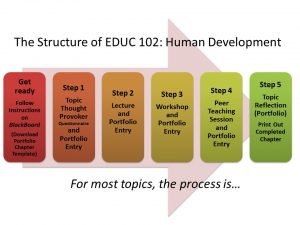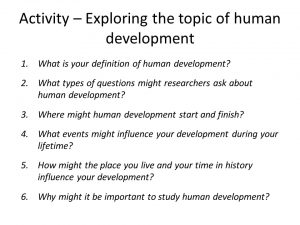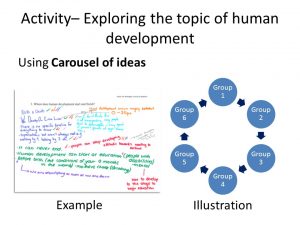This first post of With Students in Mind presents practical teaching tip #1: Design your course with students in mind
Buzz words in higher education are “flipped classroom”, “active engagement”, and “student-centred” but what do they mean? In essence, they mean that students do most of the talking and thinking during class time rather than the lecturer.
I will attempt to explain these terms with two examples from my recent experience as a teacher at the University of Otago. The first example involves the design of a course. The second example involves a teaching method I love to use with students.
Example 1: Course Design
In 2016, I was part of a team responsible for teaching a first-semester, first-year undergraduate course about human development at the College of Education. Not only were there students from the primary and early childhood programmes enrolled in the course, but about one-third of students came from other departments from across the university, including: law, physical education, psychology, and social work.
For many students in the course, this was their first time at university. We wanted their initial experiences to be positive and to model the methods that many of them could use as future teachers, lawyers, and social workers. Despite the constraints of the university setting (i.e., little control over timetable and limited fact-to-face teaching time), we designed the course with a student-centred approach.
Our approach involved one-hour lectures that introduced the weekly topic and involved students in active discussions and thought-provoking activities. To make teaching more complicated, the course was taught collaboratively across two campuses, in Dunedin and in Invercargill. We streamed the lecture live from Dunedin to Invercargill but the remainder of the course was taught face-to-face in smaller settings. The quality of the live stream was not always predictable but, fortunately, our teaching colleague at the Southland campus was well versed in the course material and could improvise when necessary.
Next, students attended a two-hour workshop where they explored, discussed, and wrote about their understanding of the weekly topic more extensively than in the lecture. Finally, students attended a one-hour student-led tutorial session that was structured around the readings from the course textbook. Student were responsible for peer-teaching aspects of the weekly topic to one another in collaborative groups. As students progressed through the week, the teaching became less teacher-directed and ‘flipped’ to more student-driven. Progressively, we put the onus on students to be responsible for actively engaging with the course material.
To help students monitor and adjust their learning efforts, they were asked to complete two additional activities each week. The first activity was a thought-provoker questionnaire that contained 10-15 statements related to the weekly topic. Students were asked to respond to the statements using a Likert-like rating scale. Student responses were incorporated into the weekly lecture. The second activity was a written portfolio. Students were asked to download a portfolio ‘chapter’ each week. In addition to a set of questions to guide students’ reading of the textbook that week, each chapter contained reflective prompts about the questionnaire, lecture, workshop, and peer-teaching session. These course elements allowed students to see similarities and differences among topics, draw on their personal experiences, and make connections to their career goals.
Example 2: An active student-centred teaching method
A challenge I faced when teaching this course was facilitating over 160 students divided into four groups of students during their tutorial and workshop sessions. To encourage over 40 students per workshop to participate actively, one of the teaching methods I’ve used is called Carousel of Ideas. I’ve outlined how I’ve used this method briefly below.



To extend the carousel of ideas further, each group can prepare a summary of the key ideas about their question and nominate a speaker who will present their group’s summary to the class. My only job, once I’ve outlined how the carousel of ideas will operate, is to keep track of the time and make certain that students pass the papers to the next group in the right order.
Hopefully, these two examples have provided you with sufficient detail to begin your appreciation of the terms “flipped classroom”, “active engagement”, and “student-centred”. These terms will be revisited and further developed in the next blog of With Students in Mind when practical teaching tip #2 will be about asking your students for feedback.

